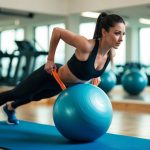
Enhancing Balance and Stability
Balance and stability are vital for functional fitness. Activities targeting these components help improve body control, reduce the risk of injury, and increase overall coordination. Core strength is essential here, providing foundational support.
Balance exercises often incorporate tools like balance boards or stability balls. These routines help enhance proprioception, enabling the body to adjust and maintain performance during various physical tasks. Developing stability is linked to improved functional movements, benefiting everyday activities.
Developing Flexibility and Mobility
Flexibility and mobility contribute significantly to functional fitness. Flexibility focuses on the ability of muscles to stretch through a range of motion. Meanwhile, mobility emphasizes the function and range of joints.
Dynamic stretching and yoga can improve both aspects, increasing muscle pliability and joint function. These practices support functional exercises by improving movement efficiency and reducing the risk of injuries. Consistent work on flexibility and mobility ensures better readiness for physical challenges.
Functional Exercises and Techniques
Functional fitness involves training the body for everyday activities. Key movements include squats and lunges for leg strength, pushing and pulling exercises like push-ups and pull-ups to enhance upper body power, and hinging along with carrying techniques for core stability and functional strength.
Squats and Lunges
Squats and lunges are fundamental exercises that target the lower body and core. Squats engage muscles such as quadriceps, hamstrings, glutes, and lower back, promoting strength and balance. Variations like front and goblet squats add intensity and challenge different muscle groups. Lunges, on the other hand, are excellent for improving unilateral leg strength and stability. They’re versatile, allowing for forward, reverse, and lateral variations, each one enhancing leg endurance and functional movement skills. These exercises are transferable to daily activities like lifting and bending, providing comprehensive lower body conditioning.
Pushing and Pulling Movements
Pushing and pulling movements are vital for upper body strength. Push-ups are a cornerstone exercise, focusing on the chest, shoulders, and triceps, while also engaging core muscles. They can be modified by adjusting hand placement or body angle to vary difficulty. Pull-ups are equally essential, targeting the back, biceps, and forearms. These movements not only support strength development but also bolster muscle endurance and coordination. Incorporating pushing and pulling in workouts helps in enhancing daily functional activities like lifting, carrying, and even posture maintenance.
Hinging and Carrying Techniques
Hinging movements primarily focus on the posterior chain, engaging muscles from the lower back to the calves. Deadlifts are a classic hinging exercise, offering comprehensive muscle activation and strength-building. Proper form is crucial, ensuring safety and effectiveness. Carrying techniques like farmers’ walks are also essential, building grip strength and improving stability. These involve holding weights while walking, emphasizing core engagement and overall endurance. Including hinging and carrying techniques in a fitness regime increases functional capabilities and supports everyday physical demands such as lifting heavy objects or maintaining balance.



